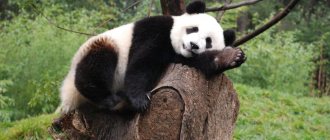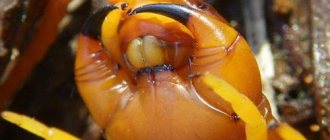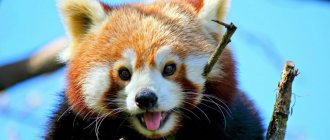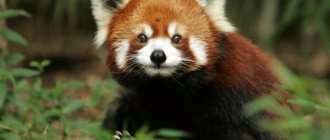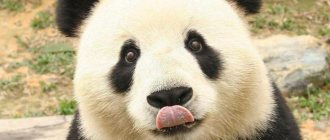- Wild animals
- >>
- Mammals
The giant panda is a unique animal, also called the bamboo bear.
Today there is a possibility of complete extinction of this species of animals from the face of the earth, and therefore they are listed in the International Red Book. Bamboo bears are a symbol and national treasure of the People's Republic of China. They are awarded the honorary title of the cutest animal on our planet. Bears are one of the most interesting, oldest and rarest representatives of the animal world on earth.
Panda habitat - in which country do they live?
Habitat of pandas
Pandas are distributed mainly in Asia, to the east of the Himalayan mountains.
At the same time, small pandas are much more common than big pandas. The animals are extremely rare; the population of giant pandas is limited to the provinces of China: Gansu, Sichuan and Shanxi, which are located in the center of the country. The habitat covers about 29.5 thousand km2, but only a small part can be considered the habitat of pandas. Interesting fact : panda is translated from Chinese as bear-cat.
Not just black and white
It turns out that there are not only pandas with traditional coat colors, and we are not talking about a random mutation or albino pandas. Within the giant panda species, there are two subspecies that have separate habitats. These are ailuropoda melanoleuca, the familiar black and white panda from Sichuan province, and ailuropoda melanoleuca qinlingensis, a panda with light brown areas instead of black, living in the Qinling Mountains (Shaanxi Province).
She doesn't look as impressive, but she's still very beautiful. It is noteworthy that the brown subspecies is smaller in size compared to its famous brother.
Panda Habitat
Panda Habitat
Pandas live in deciduous forests and mountainous areas. They feed mainly on bamboo, which is why they choose habitats where it grows. A lot of bamboo grows in the territories of Tibet and Sichuan province, so most of the animals live there. Mountain forests are simply filled with bamboo thickets. Pandas mostly live solitary lives, moving only to obtain food, systematically chewing leaves and stems of bamboo.
What is convergent evolution?
Convergent evolution is a process during which similarities appear between different organisms that belong to the same ecological guild - that is, they live in similar conditions and lead a similar lifestyle. A good example of convergent evolution is the formation of similar bodies in dolphins, ichthyosaurs and sharks, which acquired them individually, so to speak, rather than inheriting them from a common ancestor. It appears that the bamboo diet and the need to maintain bamboo stems were responsible for the genetic changes that affected the general anatomical features of the red and giant panda.
Description
Panda appearance
Panda appearance
Panda appearance
Panda appearance
Panda appearance
Giant pandas have a round head, a plump and stocky body, and a very short tail. They reach 70 cm at the shoulders. The animals have become popular because of their cute faces and black markings around the eyes and along the body. Pandas' limbs, ears, and areas around the eyes are black, while the rest of the body is predominantly white. Sometimes pandas may not have black spots, but dark red ones. Dark spots give pandas a somewhat naive, trusting appearance.
Interesting fact : It has long been believed that bamboo bears are related to raccoons.
The shoulders and neck are very wide, but the hind limbs are reduced, so the animals walk with a kind of amble. Pandas have a reproductive bone, the baculum, present in some mammals, but it is S-shaped, pointing backwards. In giant pandas, the cranial bones are connected several times; there is a large sagittal crest, widened and deepened due to the powerful wide jaws.
Interesting fact : the giant panda is considered a bear, but the red panda is considered a raccoon.
Red panda
The molars and small molars are somewhat wider and flatter than those of other bears, which is why pandas can chew hard bamboo stems. The main notable feature of the body structure is the opposed protrusion on the bunch, similar to a thumb. Scientists previously assumed that this skin protrusion was a real finger, causing confusion in the classification of animals.
Interesting fact : for a long time it was believed that pandas have six fingers, not five. This was due to a small skin growth used to break the bamboo stems.
Reference
Latin name: Ailuropoda melanoleuca (giant panda or bamboo bear)
Habitat: mountainous regions of central China: Sichuan and Tibet.
Conservation status: vulnerable species.
Weight: 17-160 kg
Length: 1.2-1.8 m
Height: 60-90 cm
Basi the world's oldest panda turns 37 https://t.co/rR6kH8RnuB pic.twitter.com/qi3cBtipBN
— Daily Mail Online (@MailOnline) January 17, 2022
Appearance: Short and thick legs with wide paws armed with strong claws. On the soles and at the base of each toe, bare pads are well developed, making it easier to hold the smooth bamboo stems. The head is massive, with large erect ears. The body is covered with thick white fur with black spots around the eyes.
Related news
Twin pandas born in China
Diet: a panda eats up to 30 kg of bamboo and shoots per day. They also eat flowers, tree bark, tree fungi, and insects. There is evidence that they sometimes feast on fish, small rodents and other animals if they manage to catch them.
Reproduction
Panda cubs
Female giant pandas become much calmer during the mating season and attract males with a special smell. Several males may compete for a female. Mating games take place throughout the spring. During the most important days of mating games, all the female’s activity ceases, they begin to get nervous and stop eating.
Interesting: Who invented beef stroganoff?
Most panda offspring appear in August-September; pregnant females carry their offspring for about 6 weeks. Newly born cubs are blind, helpless, and their entire body is covered with a thin layer of fur. Newborn cubs weigh up to 140 grams. When the baby is born, the mother takes full care of it and moves it to a position that is comfortable for sucking milk.
Newborn panda bears
Interesting fact : for some time after birth, pandas are only white.
Feeding a baby takes up to half an hour, and a bear cub can want to eat up to 14 times a day. The eyes open three weeks after birth, animals can move independently only after 3-4 months, and are completely weaned from milk at the age of 46 weeks. The cubs stay with their mother for up to one and a half years.
Development of panda cubs
Reproduction in captivity is very poor. Studying the behavioral characteristics of animals in captivity, scientists noticed that mostly twins are born. At the same time, the mother does not raise both cubs, giving preference to only one. With a high probability, the second cub dies from hunger.
Why does panda breed poorly in captivity?
Now pandas are considered one of the most popular animals; they can be called the stars of the animal world. The sad news is that there are practically no pandas left on the planet. This also happens because animals do not reproduce well in captivity.
Zoologists help pandas
Zoologists around the world are trying to solve the problem of panda reproduction. Scientists understand that this task is not an easy one; they are constantly studying the mating games of bears. We can say that at the moment the mating games of pandas in captivity have been studied thoroughly. Females can conceive only within a few days each year - in March, and males are ready to reproduce as early as January: their hormonal levels change, males constantly mark their territory, etc.
Males arrange battles for the female’s attention; the winner ultimately takes care of his female, waiting for her to be ready. The most persistent males bother the females - they have to flee from them. Females distinguish dominant males by their voice.
Summer is approaching, mating games gradually cease, males can no longer engage in mating games until next spring. At the same time, in the wild, animals continue to reproduce, but in captivity they become modest and may not even show any activity during mating games.
Scientists explain this laziness by the fact that in captivity the male does not always understand whether the female is ready to reproduce. This happens because the animals’ enclosures are different, there is not so much communication for the male to understand the female’s readiness to conceive. In captivity, it is necessary to create special conditions, arrange dates for the animals, during which the females can signal to the males that they are ready.
It is still difficult to establish the exact reason for the weak activity of animals in captivity. The demographic situation of bears is very complex, so scientists are constantly trying to find out the reasons and correct the situation.
Features of character and lifestyle
Photo: Animal big panda
Pandas are naturally endowed with the ability to climb trees deftly and very quickly. Despite this, they prefer to be on the ground most of the time. They are excellent swimmers. Animals are distinguished by great caution and secrecy. They try their best to hide from people. In this regard, people knew nothing about them for a very long time. Observing animals living in captivity, people noted very dignified, majestic behavior. Bamboo bears behave like real representatives of noble blood.
Interesting fact: Royalty is conveyed by special manners of behavior, especially the poses that pandas are able to take. During periods of rest, they often sit as if occupying a place of honor on a throne. They rest their backs against a tree or other support; they can place their upper limbs on a hill and cross their lower limbs.
There is no clear pattern of animal activity depending on the time of day. They can be active at any time of the day. Bamboo bears spend up to 10-12 hours a day searching for and eating food. With the onset of cold weather and lower ambient temperatures, people may sleep more than usual. However, this is not at all like bear hibernation.
Animals prefer to lead a solitary lifestyle. It is unusual for them to exist in a group setting. Each animal has its own territory, which it actively protects. Females are especially ardent defenders. Animals also do not create long and strong pairs.
Despite the fact that pandas are considered silent and secretive animals, they tend to communicate with each other through sounds. Babies who call their mother make sounds similar to whimpering or crying. When pandas greet their relatives, they make something similar to the bleating of sheep. The anger and indignation of bamboo bears is expressed by a roar. If the animal does not make any sounds, but at the same time shows a bared teeth, it is better to keep your distance, as the panda is angry and furious. In general, the animals are very friendly and not at all aggressive.
Life expectancy of a panda in the wild and in zoos
Panda at the zoo
Giant pandas are omnivorous mammals that look like ordinary bears. Animals can live in the wild for up to 15 years, sometimes they can live to a respectable age.
In captivity, pandas can live much longer - from 25 to 35 years. The longevity of pandas in zoos can be explained by the following reasons:
- constant careful care and supervision of bears, access to food is provided at all times, the diet is balanced, animals receive a lot of vitamins and nutrients from fruits;
- complete control over animal reproduction. This happens because pandas are listed in the Red Book. Animal multiplication is very important;
- constant care and vaccination of animals against various diseases, solving health problems by highly qualified veterinarians.
Interesting: Why is Chinese porcelain considered the most valuable?
The lifespan of pandas in captivity also greatly influences reproduction - females and males are rare, and mostly twins are born, of which one cub survives.
Behavior
Behavior of pandas
Pandas also differ from other bears in that they do not hibernate in winter, but as winter progresses they descend lower and lower, to the foot of the mountains. Pandas never build holes on their own, hiding in caves. Animals are not only terrestrial - they swim well and climb mountains.
Most often, giant pandas prefer a solitary lifestyle, meeting with individuals of the opposite sex only during the breeding season. Females love to play with their cubs, they get great pleasure from this, and also calm the babies. Sometimes mothers may even wake up the cub to play.
What does a panda eat?
What does a panda eat?
The energy supply is strictly distributed, the animals move very little, and as they move, they chew food and get new ones. Giant pandas can eat up to 12 hours a day. The main source of energy is bamboo leaves, stems, even roots. The animal can receive only a small part of the nutrients contained in the shoots.
Pandas are also known for their upright posture when eating. At this point, the front paws can calmly hold the stems, and a very convenient skin growth tears the bamboo apart.
The panda has a very muscular stomach, woody food is digested successfully, and a thick layer of mucus protects the intestines from chips and fragments. The diet of pandas is quite extensive, because the animals are omnivores: all parts of bamboo, various fruits, plant shoots, small mammals, fish, and some insects.
Nutrition
The panda spends more than 13 hours a day searching for food. This animal feeds mainly on young bamboo shoots, but if they are not available, it does not refuse old bamboo stems. The average panda can eat about 25 kg of bamboo per day.
Thanks to her strong and powerful teeth, she can handle tough bamboo. This is not a very high-calorie food product, so the panda has to chew it almost constantly. For a long time everyone believed that bamboo was the only food for this animal.
But later they began to notice bones in the stomachs of dead pandas. It was concluded that the panda is a predator; sometimes it can even feed on carrion. There are times when specific problems arise with food, the animal eats vines, bark, leaves, tree stems, as well as some plant roots. The animal world of the panda is given to few people to understand. They do not allow anyone into their small little world, hide it from prying eyes and lead a reclusive life.
Natural enemies of giant pandas
In the mountains and forests, pandas do not have many enemies, with the exception of clouded leopards and red wolves. These animals have now become very rare, so they do not pose a particular threat. Pandas are a protected species listed in the Red Book; the decline in the number of individuals began mainly due to the activities of people who destroyed natural habitats.
Red Wolf
Thus, pandas have no enemies more terrible than humans. Bears are extremely friendly towards people, often letting them get close to them, which people often take advantage of. They are killed for their valuable fur, which is then sold on black markets. Bears are often captured in zoos.
Population and species status
Pandas are currently on the verge of complete extinction and are listed in the Red Book. No more than two thousand bears live in China, the birth rate is constantly declining, and poaching, on the contrary, is flourishing in full force. People cut down forests where pandas can live comfortably. Deprived of their habitat, animals die. Food sources are also constantly being depleted by humans. Bamboo itself can grow for 20 years. The natural death of bamboo also greatly affects pandas.
Interesting fact : the cultural revolution had no effect on maintaining the number of individuals; they continued to be constantly killed and exterminated for the extraction of very expensive fur.
In the 21st century, the last individuals may disappear. Humanity is only now beginning to understand how serious harm it has caused to nature. In China, new reserves and zoos are constantly being created, the government is introducing new bans and increasing responsibility for harm caused to pandas. However, efforts bring little benefit - animals in captivity reproduce worse. Every bear cub born is a real pride and achievement of scientists.
Interesting: Why does tea in bags brew faster than loose leaf tea?
Giant panda conservation
Giant pandas are protected at the legislative level in China. Animals have long been listed in the Red Book; serious penalties for murder include even life imprisonment in Chinese prisons. The country considers pandas to be its national treasure, which should be protected with all its might.
Now there are more and more reserves. In zoos, pandas are provided with better conditions, where they can live much longer than in the wild. The number of bears begins to gradually increase, but the process of at least partial restoration of the population will take more than one decade. There are reserves in central China, South Korea, and the United States, where pandas also breed. A small increase in the number of individuals leads to the fact that the endangered species has been transferred to the status of vulnerable, which is good news.
Interesting fact : the panda is a symbol of the WWF.
Emblem of WWF - World Wildlife Fund
The panda is a unique, interesting animal that lives only in certain areas of the planet. Pandas become characters in various cartoons; the image of the animal is a symbol of world organizations for the protection of nature, for example: WWF - World Wildlife Fund. Pandas are also recognized as a national treasure of the People's Republic of China.
The role of pandas in the ecosystem
Giant pandas live only in areas where bamboo grows, which makes up the majority of their diet. The panda population and the amount of bamboo in an area are closely related. By eating the stems, animals spread bamboo seeds to nearby areas, but animals are also rapidly reducing the amount of bamboo. By doing this they themselves complicate their lives. Thanks to protected areas where animals live, natural ecological systems are preserved.
Interesting fact : Killing pandas in China can result in execution or life imprisonment.
Chow bears
Looking at chow chow babies, you might think that these are little bear cubs. But, in reality, they are puppies of this breed, artificially colored so that there is an external resemblance to the cubs of the famous panda. Nowadays it is considered quite a fashionable trend in China, in which fluffy Chow dogs undergo a thorough modification in the form of haircuts and coloring. This manipulation can be performed by any owner for his pet so that he looks like a furry funny bear.
The session takes approximately 2 hours, and the panda disguise lasts only 1.5 months. But the consolation is that the procedure is completely harmless for the animal.
In their natural habitat, animals have no enemies, but, nevertheless, these beautiful creatures of nature are completely unprotected from natural disasters. A huge threat to animals is the period of mass flowering of their favorite bamboo. Being a long-lived plant, it can bloom only once during its entire existence, followed by complete death. With its mass death on huge plantations, pandas are completely left without food. The only salvation for them is migration to other territories where there are areas where their favorite delicacy grows.
Although in modern China there are few natural places left where bamboo grows.
But thanks to their iconic position in the country and unimaginable popularity, pandas are protected from extinction by the investment of huge amounts of money by the Chinese government in a program of strict protection and assistance in breeding these unique animals.
Economic significance for humans
Positive
Giant pandas have been constantly poached for their valuable fur. According to some beliefs, a rug made of skin will protect a person sleeping on it from attacks by night ghosts, and will also show the near future. In Japan, you can buy panda skin for a considerable price. Giant pandas are extremely popular; zoos make a lot of money by allowing people who want to see the strange animals on their premises.
Negative
Bamboo bears pose little threat to the economy due to the fact that they are extremely rare. Of course, keeping pandas in nature reserves reduces the number of territories that could be used for agriculture, but pandas are too rare a species that brings a lot of money to the state. Therefore, the benefits of animals are disproportionately greater than the negative consequences.
Scientific classification
- Domain: eukaryotes
- Kingdom: Animals
- Subkingdom: eumetazoans
- No rank: bilaterally symmetrical
- No rank: deuterostomes
- Type: chordates
- Subphylum: vertebrates
- Infratype: gnathostomes
- Superclass: quadrupeds
- Class: mammals
- Subclass: animals
- Infraclass: placental
- Superorder: Laurasiotherium
- Order: carnivores
- Suborder: Caniformes
- Family: bears
- Genus: giant pandas
- Species: giant panda
Who started a detailed study of the paws of the big and small pandas?
Researchers from the Institute of Genetics and Developmental Biology of the Chinese Academy of Sciences began studying this issue. Scientists from the British Sanger Institute provided them with significant assistance.
A giant panda got a false toe thanks to its bamboo diet.
Although both panda species share a common name, they are actually quite distant from each other in evolutionary terms, despite having common features. In fact, it was precisely due to these features that the now outdated opinion arose that the giant and red pandas are related species.

